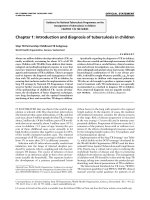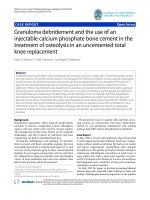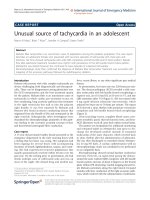Management of Candidiasis in an Indian parakeet
Bạn đang xem bản rút gọn của tài liệu. Xem và tải ngay bản đầy đủ của tài liệu tại đây (210.2 KB, 3 trang )
Int.J.Curr.Microbiol.App.Sci (2017) 6(5): 1395-1397
International Journal of Current Microbiology and Applied Sciences
ISSN: 2319-7706 Volume 6 Number 5 (2017) pp. 1395-1397
Journal homepage:
Short Communications
/>
Management of Candidiasis in an Indian Parakeet
S. Divya* and M. Areshkumar
AK Pet Clinic, Chennai, Tamil Nadu, India
*Corresponding author:
ABSTRACT
Keywords
Candidiasis,
Ketoconazole,
Indian parakeet.
Article Info
Accepted:
17 April 2017
Available Online:
10 May 2017
A ten months old female parakeet reported with the history of in appetence,
leukoid plaques around commissures of the mouth and oral cavity. Clinical
examination revealed that leukoid plaques were noticed on the tongue and
commissures of mouth. All other vital parameters were normal. The
parakeet was treated with tablet ketoconazole @ 50 mg/kg body weight
orally for 7 days along with vitamin and mineral supplements. After a week
of treatment plaques were subsided and parakeet recovered uneventfully.
Introduction
Candida albicans is the yeast normally found
in the healthy birds as commensal organism
which is present in the digestive, urinary and
reproductive tracts (Mancianti et al., 2002). It
is a very common cause of stomatitis in birds,
particularly in young, immunosuppressed
birds, those on antibiotics and in lorikeets
because of the high sugar content of some
nectar mixes.
The primary fungi of concern to the avian
practitioner are Candida albicans and
Aspergillus fumagatis. Candida albicans is
more commonly seen in birds kept in high
humidity and warm temperatures. It is more
prevalent in birds being hand-reared and kept
in brooders, and in birds kept in tropical
climates (Tully et al., 2000). Candida is an
opportunistic parasite, hence takes upper hand
when the bird become ill or stressed and also
prolonged use of antibiotics, vitamin A
deficiency,
trichomoniasis,
unhygienic
conditions and avian pox (Speer, 1995;
Schmidt et al., 2003; Godoy, 2007).
Candida causes lesions around the
commissures of the mouth and nares and
occasionally around feather follicles on the
head, back and ventral abdomen. Price et al.,
(1982) reported that the candida spp.
producing hydrolytic enzymes, which makes
the species easier its penetration into tissues
and favors their pathogenicity. The
appearance of the lesions known as ‘cotton
mouth’ as the candida plaques can look like
threads of cotton wool spread on the mucous
membranes.
A 10 months old female Indian parakeet
reported with the history of in appetence,
1395
Int.J.Curr.Microbiol.App.Sci (2017) 6(5): 1395-1397
leukoid plaques around commissures of the
mouth and oral cavity.
Clinical observation and diagnosis
On collection of history, it was noticed that
the bird was hand fed with bread and some
house hold food and fruits (Fig. 1a). Clinical
examination revealed that leukoid plaque was
noticed on the tongue and commissures of
mouth (Fig. 1b). All other vital parameters
were normal.
Samples were collected on glass slide and
examined under microscope after staining
with methylene blue (Fig. 1c).
Treatment and out come
The
parakeet
was
treated
with
ketoconazole @ 50 mg/kg body weight (Tully
et al., 2000) orally once a day along with
vitamin and mineral supplements. Advised
the owner not to hand feed the parakeet with
bread and to provide healthy and nutritious
food. After 7 days of treatment the plaques
was subsided and animal is doing well.
Results and Discussion
Candidiasis is evidenced by large numbers of
typical organisms. Candida can be a normal
inhabitant of the upper alimentary tract, hence
low numbers of organisms do not produce
inflammation. An inflammatory response
often occurs when the infection has involved
themucosa. The presence of hyphae formation
suggests a potential systemic invasion by the
yeast (Doneley, 2010).
tablet
Fig.1(a) Bird suffered with candidial plaque (b) Leukoid plaque on the tongue and commissures
of mouth (c) Microscopic examination methylene blue stain
(a)
(b)
(c)
Candida albicans is often detected by Gram
stain in the droppings of birds eating yeastcontaining feedstuffs (e.g. bread, biscuits).
Unless the yeast are numerous and budding,
or can be cultured in heavy numbers, they
have little or no clinical significance.
Development of pseudohyphae, seen on Gram
staining, is significant and may indicate
invasion of the intestinal mucosa by the yeast
(Doneley, 2010). In this case the methylene
blue staining technique was useful in
detecting the organism quickly (Kucsera et
al., 2000).
Although, most veterinary texts consider C.
albicans as the only species of the genus
involved in the infections of the digestive
tract of psittacines birds (Harrison, 1986;
1396
Int.J.Curr.Microbiol.App.Sci (2017) 6(5): 1395-1397
Speer, 1995; Schmidt et al., 2003). Vieira and
Selene (2009) reports species non-albicans of
the genus Candida as responsible for
infections in birds. The bird responded well to
the ketoconazole at the dose rate of 50mg/kg
body weight and complete recovery was
noticed in seven days.
Nutritional problems, especially those
resulting from an unbalanced diet, are often
seen in mixed aviaries and individual pet
finches. All carnivorous birds need a certain
amount of supplementation by an egg-food or
‘soft bill’ food, as an unbalanced diet
predisposes birds to health problems,
especially with Enterobacteriaceae (e.g. E.
coli, Klebsiella spp. and Enterobacter spp.)
and yeast infections (especially Candida
albicans). The breeding results are poor in
birds with an unbalanced diet (Tully et al.,
2000a).
The risk of candidiasis can be prevented by
providing a clean environment and proper
nutrition, reducing or eliminating any causes
of stress, and preventing contact with any
potentially sick bird.
References
Doneley, B. 2010. In: Interpreting Diagnostic
Tests, Avian Medicine and Surgery in
Practice (Companion and aviary birds.
Manson Publishing Ltd), Pp: 83.
Godoy, S.N. 2007. Psittaciformes. In: Cubas Z.S.,
Silva J.C.R. & Catão-Dias J.L. Eds),
Tratado
de
Animais
Selvagens:
Medicinaveterinária. Roca, São Paulo. P:
222-251.
Harrison G.J. 1986. Clinical Avian Medicine and
Surgery, W.B. Saunders, Philadelphia. PP:
717.
Kucsera, J., K. Yarita and K. Takeo. 2000. Simple
detection method for distinguishing dead
and living yeast colonies. J. Microbiol.
Methods, 41(1): pp: 19-21.
Mancianti, F., S. Nardoni and R. Ceccherelli.
2002. Occurrence of yeasts in psittacines
droppings from captive birds in Italy.
Mycopathologia, 153. pp: 121-124.
Price, M.F., I.D. Wilkinson and L.O. Gentry.
1982. Plate method for detection of
phospholipase activity in Candida albicans.
Sabouraudia, 20: pp. 7-14.
Schmidt, R.E., D.R. Reavill and D.N. Phalen.
2003. Pathology of Pet and Aviary Birds.
Iowa State Univ. Press, Ames, Pp: 234.
Speer, B.L. 1995. Infectious diseases. In:
Abramson J., Speer B.L. & Thomsen J.B.
Eds), The Large Macaws: Their care,
breeding and conservation. Raintree
Publications, Fort Bragg. p.310
Tully, Jr. T.N., G.M. Dorrestein and A.K. Jones.
2000. In: Fungal diseases, Hand book of
Avian Medicine, 2nd Edi. Reed Educational
and Professional Publishing Ltd. Pp: 138.
Tully, Jr.T.N., G.M. Dorrestein and A.K. Jones.
2000a. In: Metabolic and nutritional
disorders, Hand book of Avian Medicine,
2nd Edi. Reed Educational and Professional
Publishing Ltd. Pp: 161.
Vieira, R.G. and D.A.C. Selene. 2009.
Phenotypical characterization of Candida
spp. Isolated from crop of parrots
(Amazona spp). Pesq. Vet. Bras., 29(6) pp.
452-456.
How to cite this article:
Divya, S., and Areshkumar, M. 2017. Management of Candidiasis in an Indian Parakeet.
Int.J.Curr.Microbiol.App.Sci. 6(5): 1395-1397. doi: />
1397









